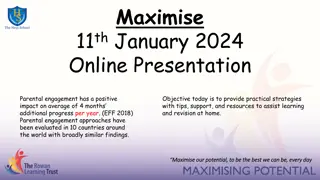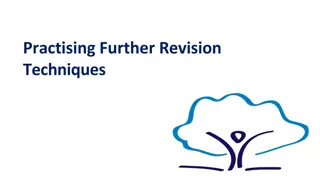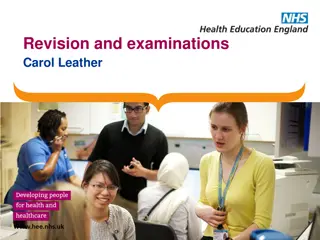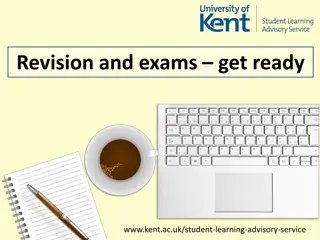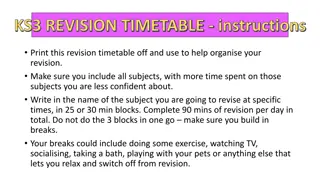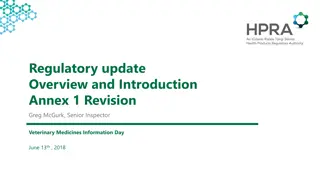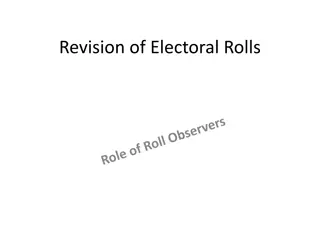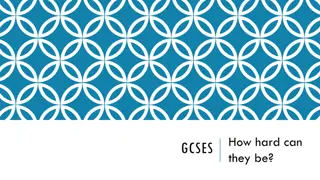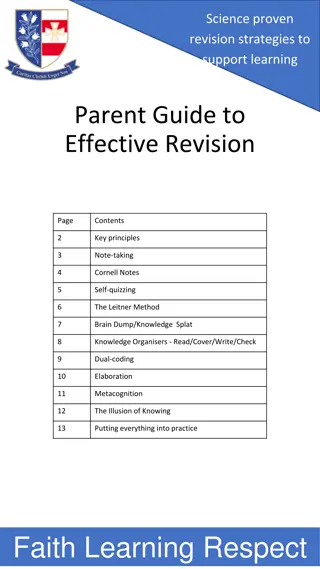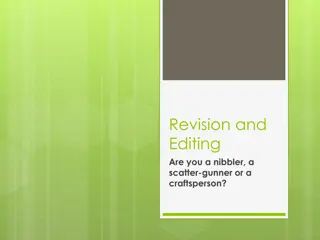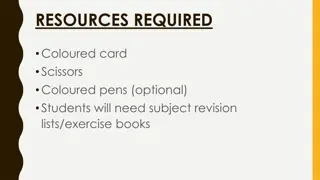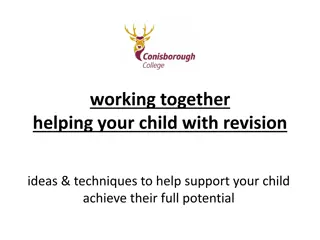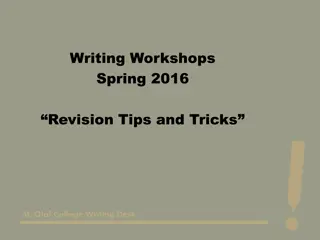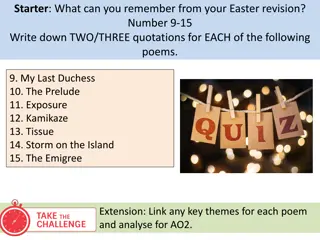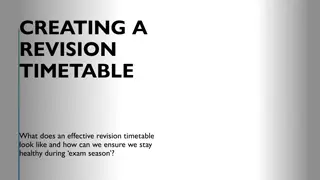Future Planning and Revision Strategies for Success
Explore pathways for future career options and effective revision techniques. From mind mapping career choices to utilizing three-color revision methods, you'll find practical tips and resources to enhance your academic journey.
Download Presentation

Please find below an Image/Link to download the presentation.
The content on the website is provided AS IS for your information and personal use only. It may not be sold, licensed, or shared on other websites without obtaining consent from the author. Download presentation by click this link. If you encounter any issues during the download, it is possible that the publisher has removed the file from their server.
E N D
Presentation Transcript
LIVING THE DREAM! Planning Pathways for the Future
MINDMAPYOUR OPTIONS Think about the career you want when you finish school. Do a similar mindmap, completing the areas about subjects, college/uni, modern apprenticeships, what the job involves and alternative careers in a similar field.
REVISION TIPS www.bbc.co.uk/programmes/articles/.../revision-basics
THREE COLOUR REVISION Find a partner and agree on a subject and topic e.g. History, World War One, Reasons why the war started. On your own, write everything you can think of on this topic in one colour (either another colour of pen or have three highlighters). You have 5 minutes. Then look over your partners work and include, in a different colour , any information they had, which you didn t. Then, look over your jotter/text book and include, in a third colour, any information you both missed. The first colour is information your are secure with. The second and third colours are areas you should concentrate on for revision.
EXAMPLE Arms race: Germany was building up her navy to try and match Britain s large navy Britain had the largest Navy fleet as she was an island and this was the best form of defence. The assassination of Archduke Franz Ferdinand in Sarajevo by Gavrilo Princip. The number of alliances across Europe meaning that if one country was pulled into war, it was likely they all would be. Armies of France and Germany had doubled in the lead up to the war. The British introduced a warship called the Dreadnought which led to the German producing their own version. The Schlieffen Plan. Imperialism and countries wanting empires overseas. Bismarck s building of a Greater Germany. The Dual Alliance, The Triple Alliance, The Entente Cordiale, The Triple Entente. Your KU What you should concentrate your revision on Partner s KU Extra KU
MINDMAPPING http://www2.open.ac.uk/students/skillsforstudy/demo-creating-a-mind-map.php The subject you are discussing should be in the middle. All other arms will come from it. For example, say you were doing a mindmap for themes in the novel Private Peaceful . Themes in Private Peaceful
MINDMAPPING You then add on the themes you can think of: War and its brutality Love Themes in Private Peaceful Family Sacrifice and putting others first
MINDMAPPING Relationship between Tommo and Charlie And then add examples in the novel of that theme. Relationship between Tommo, Charlie and Big Joe Family Themes in Private Peaceful
MINDMAPPING Then examples showing the relationship between them and them quotes from the book showing this. The thing is, Sergeant, even if I wanted to, I can t go with you because I d have to leave Tommo behind, and I can t do that. p. 172 Charlie refuses to leave Tommo behind Relationship between Tommo and Charlie
MINDMAPPING You would then work your way around the mindmap completing it in this way. You could colour code it if you wished, and have each theme as a separate colour and all things relating to that theme as the same colour. Do a mindmap for a subject/topic of your choice.
MAKING NOTES WHY TAKE NOTES? Focuses your attention and stops your mind drifting Makes you think about what you are reading and lets you make sense of it. Encourages you to reflect upon what you are reading. Helps to move the information from your short term to long term memory. Is something to revise. http://www.youtube.com/watch?v=UAhRf3U50lM
MAKING NOTES WAYS TO APPROACH IT You can highlight the sentences which give us the main points in a paragraph. Edinburgh Castle is situated on Castle Rock in the city of Edinburgh, Scotland. Castle Rock formed after a volcano erupted over 340 million years ago. The first castle that existed on the rock was known as The Castle of the Maidens . According to legend, the castle had been a shrine to the Nine Maidens , one of whom was Morgan le Fay. Castle Rock had been a military base and royal residence for centuries. However, the edifice that is known as Edinburgh Castle was built during the 12th century by David I, son of Saint Margaret of Scotland. The tensions between the English and Scottish monarchies nearly always centred on Edinburgh Castle. He who held the castle held rule over the city of Edinburgh and, therefore, over all of Scotland. Consequently, the castle was almost constantly under siege. The first major battle the castle witnessed was during the late 13th century when Edward I of England attempted to seize the then vacant Scottish throne. From 1296 to 1341, the castle bounced from English to Scottish hands several times during the First and Second Wars of Scottish Independence. After the Wars of Independence, the castle was in great need of repairs. Most of the construction was overseen by David II. In his honour, David s Tower was erected.
MAKING NOTES WAYS TO APPROACH IT You can highlight the sentences which give us the main points in a paragraph. Edinburgh Castle is situated on Castle Rock in the city of Edinburgh, Scotland. Castle Rock formed after a volcano erupted over 340 million years ago. The first castle that existed on the rock was known as The Castle of the Maidens . According to legend, the castle had been a shrine to the Nine Maidens , one of whom was Morgan le Fay. Castle Rock had been a military base and royal residence for centuries. However, the edifice that is known as Edinburgh Castle was built during the 12th century by David I, son of Saint Margaret of Scotland. The tensions between the English and Scottish monarchies nearly always centred on Edinburgh Castle. He who held the castle held rule over the city of Edinburgh and, therefore, over all of Scotland. Consequently, the castle was almost constantly under siege. The first major battle the castle witnessed was during the late 13th century when Edward I of England attempted to seize the then vacant Scottish throne. From 1296 to 1341, the castle bounced from English to Scottish hands several times during the First and Second Wars of Scottish Independence. After the Wars of Independence, the castle was in great need of repairs. Most of the construction was overseen by David II. In his honour, David s Tower was erected.
MAKING NOTES WAYS TO APPROACH IT Using a text, write five key words, which sum up the content of the text. Edinburgh Castle is situated on Castle Rock in the city of Edinburgh, Scotland. Castle Rock formed after a volcano erupted over 340 million years ago. The first castle that existed on the rock was known as The Castle of the Maidens . According to legend, the castle had been a shrine to the Nine Maidens , one of whom was Morgan le Fay. Volcano David I Siege Edward I Wars of Independence Castle Rock had been a military base and royal residence for centuries. However, the edifice that is known as Edinburgh Castle was built during the 12th century by David I, son of Saint Margaret of Scotland. The tensions between the English and Scottish monarchies nearly always centred on Edinburgh Castle. He who held the castle held rule over the city of Edinburgh and, therefore, over all of Scotland. Consequently, the castle was almost constantly under siege. The first major battle the castle witnessed was during the late 13th century when Edward I of England attempted to seize the then vacant Scottish throne. From 1296 to 1341, the castle bounced from English to Scottish hands several times during the First and Second Wars of Scottish Independence.
MAKING NOTES WAYS TO APPROACH IT You would then use these words as headings and write about them, in your own words, so that you have a description/explanation of each. You could do this with your book closed if you wanted to test your knowledge! Volcano A volcano erupted 340 million years ago and created Castle Rock. This is the rock in Edinburgh upon which Edinburgh Castle sits.
MAKING NOTES WAYS TO APPROACH IT You can make a table and in one column write what the writer says in the text, then in the other expand on it with what you think this means. What the writer says What I think Whoever held Edinburgh Castle had control of Edinburgh, and so control of Scotland. Edinburgh was really important to the people who wanted to run Scotland both Scottish and English. This is why many battles centred around Edinburgh Castle. Many of the battles between Scotland and England during the Wars of Independence were fought for Edinburgh Castle.
REVISION TIPS http://www.youtube.com/watch?v=Jp2Clw_fm1I http://www.youtube.com/watch?v=0z4BezTzOFs http://www.youtube.com/watch?v=SoLaueXOzVQ
MAKE A REVISION TIMETABLE http://www.bbc.co.uk/scotland/learning/studyski lls.shtml Make a plan Suss out how much work you have to cover and how much time you have before the exams then draw up a realistic timetable. Switch between subjects to avoid becoming bored of a single topic. The most effective way to revise is to concentrate on understanding rather than memorizing. Remember to give enough coverage to each subject.
MAKE A REVISION TIMETABLE You can write it down in blocks or you can create a timetable like your school timetable whichever suits you best! You may also wish to colour code each subject, that way you will be able to see how much time you are giving to each subject at a glance.
TEACH OTHERS! One of the best way to learn information is to teach someone else! Prepare a brief activity for someone else to do on a topic you have learned. Make sure you provide them with the information they need. For example: if you are learning a poem, why not write some questions and an answer key for someone else to try? Or you could take a theme of the poem and teach how that comes through. Provide the quotes and explain how they demonstrate this. How would you teach this to others? Come up with a task and teach it to another member of the class.
TEST YOURSELF Take 5 minutes to revise a section of a subject of your choice. Now get a partner to ask you questions. Take a note of the questions you got wrong you should concentrate on revising these parts a little more.





